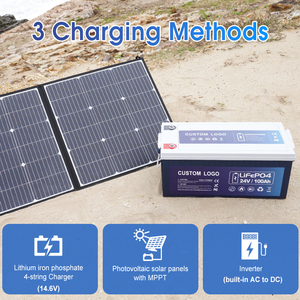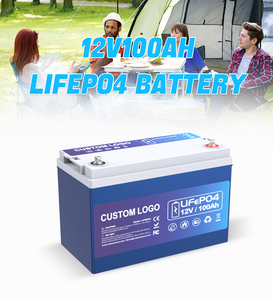
All categories
Featured selections
Trade Assurance
Buyer Central
Help Center
Get the app
Become a supplier

(50371 products available)














































The Lithium-ion lithium-ion 12V 400AH deep cycle battery is light for its weight. It can be used in many ways since it can be mobile and used at home. They are easy to transport, making them ideal for RVs and boats. Lithium battery technology provides good energy density.
A Gel 12V battery is another option for a deep cycle battery. Gel batteries use a silica additive to suspend the acid in the electrolyte solution, creating a thick, gluey substance. The low resistance and highly viscous nature help increase the battery strength to vibration and temperature.
AGM, short for absorbed glass mat batteries, is a rechargeable lead-acid battery with fiberglass mats installed between the lead plates to absorb the electrolyte solution. AGM 12V batteries for solar systems are popular in applications with frequent power surges and recharging because of their low internal resistance.
These batteries are the most common type of deep cycle battery, and they account for about 80% of all deep cycle battery usage. They are the oldest and most inexpensive batteries. Flooded lead acid batteries are intended for stationary applications.
The 400Ah lithium battery bank system stores energy from renewable sources such as solar panels and wind turbines. This stored energy can be used when these sources are unable to generate, like during the night or on cloudy days.
Flooded lead-acid batteries give an affordable solution for customers since they are inexpensive and can be used with many different battery configurations. They perform well with large daily cycles of charging and discharging.
Deep cycle batteries are heavily used in electric forklifts in industries where lifting goods is practiced. Other industrial vehicles like pallet trucks and lift tables also use deep cycle batteries to drive the DC motor electrical system.
Cable and pipe installation for monitoring systems in mining, oil and gas, and other industries is expensive and often impractical. Deep cycle batteries provide sufficient power for remote monitoring systems located far away from electrical infrastructure.
Deep cycle batteries power emergency backup lighting systems and portable work lights used in industrial applications. This includes systems and areas where the lighting must stay on even when the electrical circuit is interrupted.
Many industrial systems have EPO switches to turn off the main power and all system interlocked equipment. Deep cycle batteries ensure these switches operate even when the main power source fails.
Cycle life refers to the number of charging and discharging cycles a battery can go through before its capacity diminishes significantly. Lithium-ion batteries usually go up to 2000-5000 cycles. They retain their capacity for longer than lead-acid batteries.
The 400Ah capacity denotes how much energy the battery can hold. The more the capacity, the longer the battery will run appliances before needing to be recharged.
Deep cycle lithium-ion batteries are lighter and stronger than lead-acid models. They are easy to install since there is no need for maintenance and no topping off water. Lithium-ion batteries discharge about 85-95% of their capacity.
Lithium-ion deep cycle batteries use advanced technology to keep the internal battery components safe and operating well. This makes them safe for use. There are also built-in protections from overcharging, overheating, high and low voltage, and short-circuiting.
Deep cycle lithium-ion batteries, unlike other types, have no need for maintenance. They do not require topping off or checking the water and acid levels, and no cleaning the terminals and plates is necessary. This helps them be more suitable for remote work areas. Users just need to install them and forget about them until the depletion time comes.
Lead-acid batteries need maintenance. To check the battery state, technicians have to open the insulated cover and remove batteries from the compartment. Lead-acid batteries are primarily non-maintainable, requiring technicians to add water and replace worn batteries. Some lead-acid batteries are designed with removable caps that allow water to be added when the battery is low.
Do not buy a 12-volt 400-amp deep cycle battery based on the price alone. Batteries manufactured by well-known brands have premium prices because of their reputation for producing quality products. Check the manufacturer's date. Batteries can be more sensitive to temperature and tend to degrade faster when exposed to heat.
Batteries that are too old might not have their full capacity. Batteries manufactured before this date should not be used in industrial applications. Choose a maintenance-free battery. These include gel and AGM batteries.
Physical damage, such as cracks, dents, or bulging cases, may indicate internal damage to the battery. This could cause safety issues due to leaking acid or gases. A swollen battery may have excess gases building up inside the battery case. This could cause the battery to eventually explode.
A cracked or dented battery might not be safe to use since it may be broken internally and expose hazardous chemicals. Batteries with fluid leaking from the case should not be touched directly. The acid is corrosive and will cause chemical burns.
Old or worn batteries should be disposed of properly in hazardous material containers. They may contain lead or other heavy metals and are considered hazardous waste.
Deep cycle batteries, especially lead-acid and lithium-ion batteries, are hazardous due to the acids, lead, and lithium or other metals in the industrial 12v battery. Do not throw deep cycle batteries in the regular garbage. Take them to a hazardous waste depot or recycling centre that accepts old batteries.
Some states have battery recycling programs that give financial incentives for returning lead-acid batteries. Contact the local environment agency or look on their website for information. Many manufacturers have take-back programs that make it easy to return old batteries for recycling.
A1. Deep cycle batteries are designed to be regularly deeply discharged using up most of their stored energy and then recharged. Unlike regular car batteries, which are designed for short-term use and heavy recharging.
A2. Typically, lithium-ion batteries can last anywhere between 5 and 10 years with proper care and usage.
A3. Regular starter batteries provide quick bursts of power to start an engine and are not designed to be deeply discharged. Deep cycle batteries, on the other hand, are specifically designed to be slowly discharged almost completely and fully recharged repeatedly over time.
A4. The main difference between AGM and gel batteries lies in the electrolyte absorption and viscosity characteristics. AGM batteries utilize an absorptive glass mat separator saturated with electrolyte.
A5. Deep cycle batteries typically last between 3 to 10 years. After this timeframe,” the batteries may lose some capacity. Lead-acid batteries have shorter life spans of around 3 to 5 years.